Analyzing Diversity and Learning: Rights of All Students to Education
VerifiedAdded on 2023/06/05
|9
|2105
|286
Essay
AI Summary
This essay explores the critical importance of inclusive education, emphasizing the rights of all students to access quality education regardless of their background or abilities. It highlights the need for educational institutions to challenge exclusionary practices and promote social justice through policies that support students with disabilities, including providing accessible physical and digital learning environments. The essay also discusses effective teaching strategies for diverse classrooms, such as calling on each student, fostering engagement through culturally relevant content, and utilizing cooperative base groups to build a sense of belonging. Furthermore, it addresses catering to gifted and talented learners through flexible grouping, differentiated instruction, and multi-level instruction. The essay concludes by emphasizing the significance of fostering positive teacher-student relationships and strong parent-teacher relations to maximize student learning and success. Desklib provides access to this essay and many other resources to support student learning.
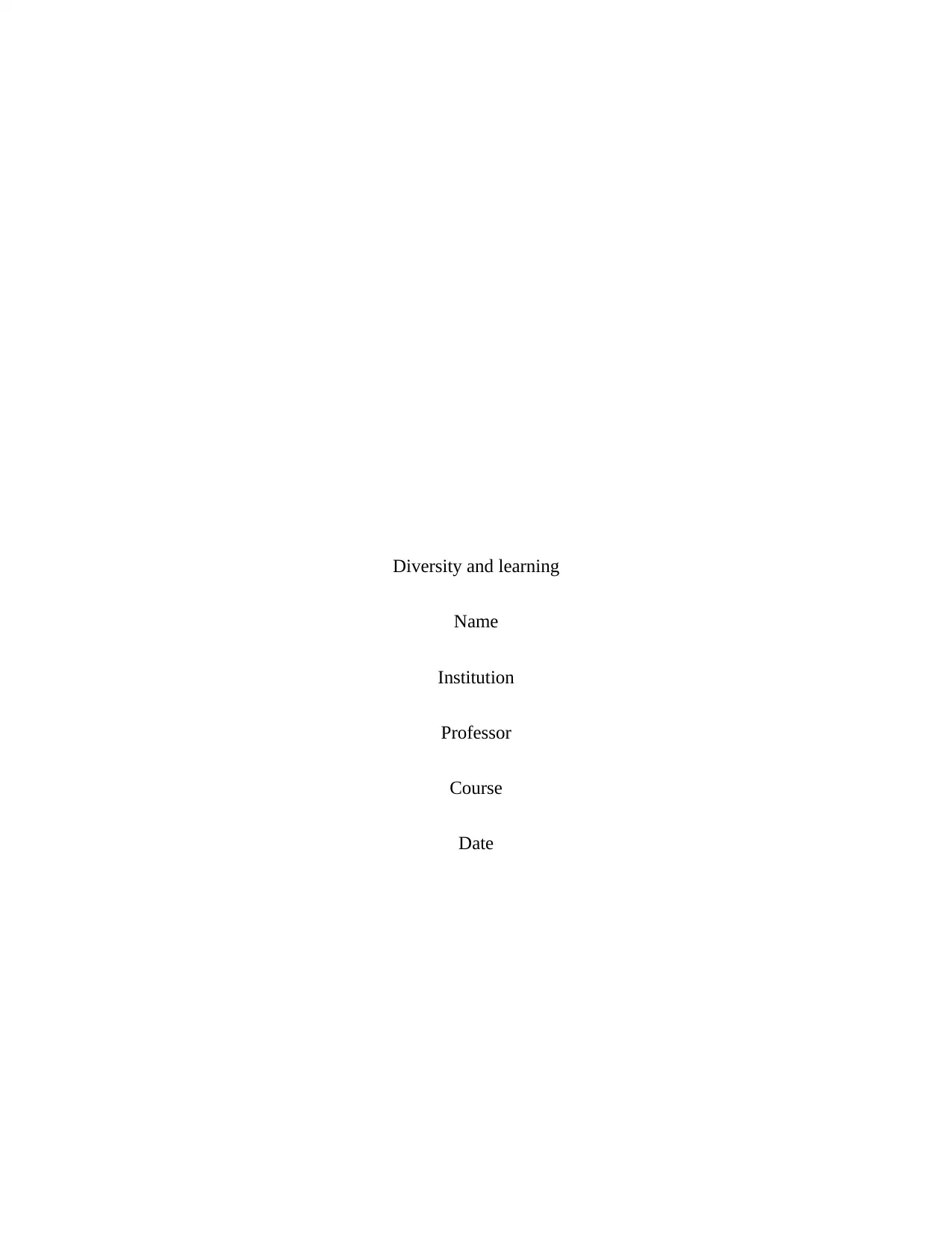
Diversity and learning
Name
Institution
Professor
Course
Date
Name
Institution
Professor
Course
Date
Paraphrase This Document
Need a fresh take? Get an instant paraphrase of this document with our AI Paraphraser
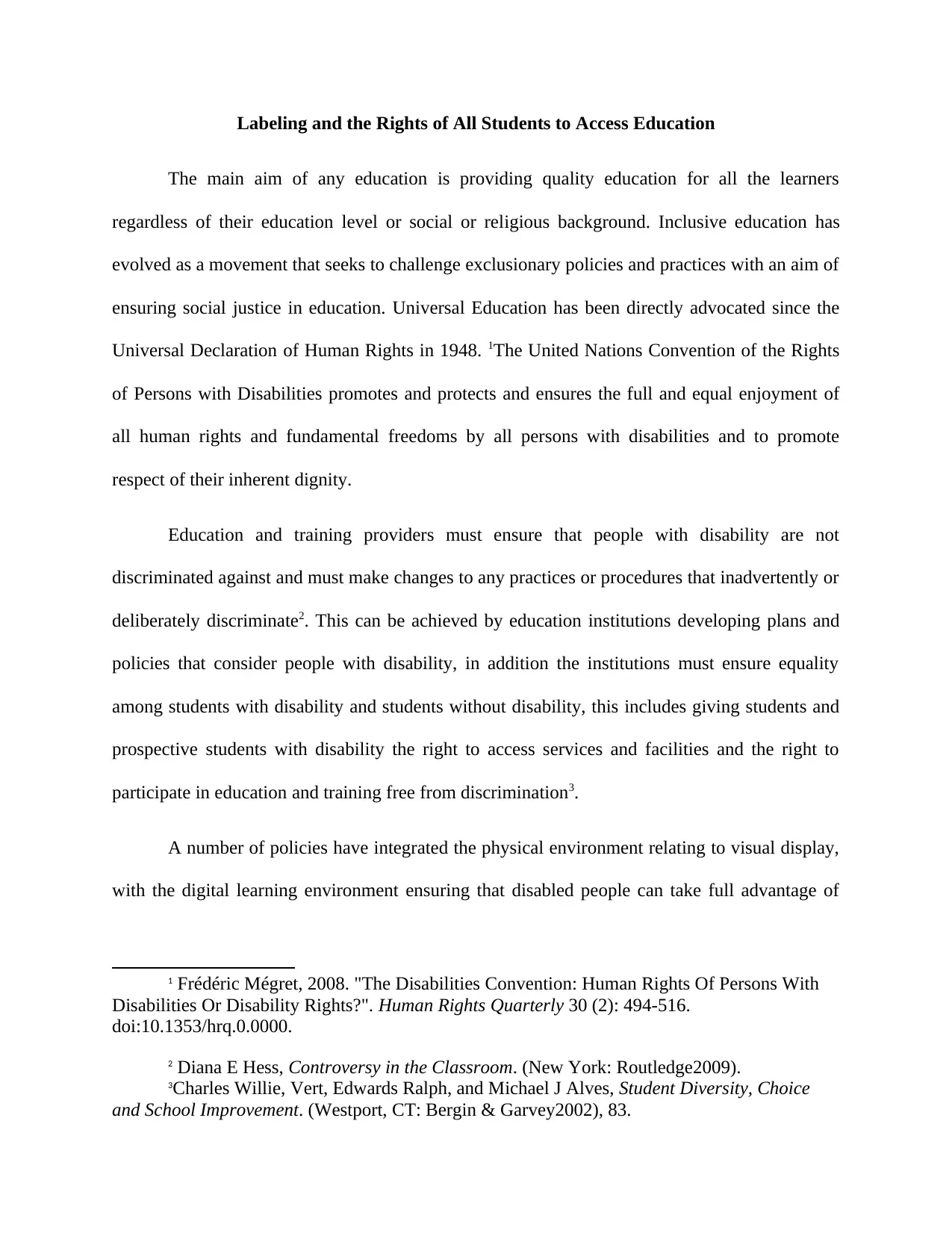
Labeling and the Rights of All Students to Access Education
The main aim of any education is providing quality education for all the learners
regardless of their education level or social or religious background. Inclusive education has
evolved as a movement that seeks to challenge exclusionary policies and practices with an aim of
ensuring social justice in education. Universal Education has been directly advocated since the
Universal Declaration of Human Rights in 1948. 1The United Nations Convention of the Rights
of Persons with Disabilities promotes and protects and ensures the full and equal enjoyment of
all human rights and fundamental freedoms by all persons with disabilities and to promote
respect of their inherent dignity.
Education and training providers must ensure that people with disability are not
discriminated against and must make changes to any practices or procedures that inadvertently or
deliberately discriminate2. This can be achieved by education institutions developing plans and
policies that consider people with disability, in addition the institutions must ensure equality
among students with disability and students without disability, this includes giving students and
prospective students with disability the right to access services and facilities and the right to
participate in education and training free from discrimination3.
A number of policies have integrated the physical environment relating to visual display,
with the digital learning environment ensuring that disabled people can take full advantage of
1 Frédéric Mégret, 2008. "The Disabilities Convention: Human Rights Of Persons With
Disabilities Or Disability Rights?". Human Rights Quarterly 30 (2): 494-516.
doi:10.1353/hrq.0.0000.
2 Diana E Hess, Controversy in the Classroom. (New York: Routledge2009).
3Charles Willie, Vert, Edwards Ralph, and Michael J Alves, Student Diversity, Choice
and School Improvement. (Westport, CT: Bergin & Garvey2002), 83.
The main aim of any education is providing quality education for all the learners
regardless of their education level or social or religious background. Inclusive education has
evolved as a movement that seeks to challenge exclusionary policies and practices with an aim of
ensuring social justice in education. Universal Education has been directly advocated since the
Universal Declaration of Human Rights in 1948. 1The United Nations Convention of the Rights
of Persons with Disabilities promotes and protects and ensures the full and equal enjoyment of
all human rights and fundamental freedoms by all persons with disabilities and to promote
respect of their inherent dignity.
Education and training providers must ensure that people with disability are not
discriminated against and must make changes to any practices or procedures that inadvertently or
deliberately discriminate2. This can be achieved by education institutions developing plans and
policies that consider people with disability, in addition the institutions must ensure equality
among students with disability and students without disability, this includes giving students and
prospective students with disability the right to access services and facilities and the right to
participate in education and training free from discrimination3.
A number of policies have integrated the physical environment relating to visual display,
with the digital learning environment ensuring that disabled people can take full advantage of
1 Frédéric Mégret, 2008. "The Disabilities Convention: Human Rights Of Persons With
Disabilities Or Disability Rights?". Human Rights Quarterly 30 (2): 494-516.
doi:10.1353/hrq.0.0000.
2 Diana E Hess, Controversy in the Classroom. (New York: Routledge2009).
3Charles Willie, Vert, Edwards Ralph, and Michael J Alves, Student Diversity, Choice
and School Improvement. (Westport, CT: Bergin & Garvey2002), 83.
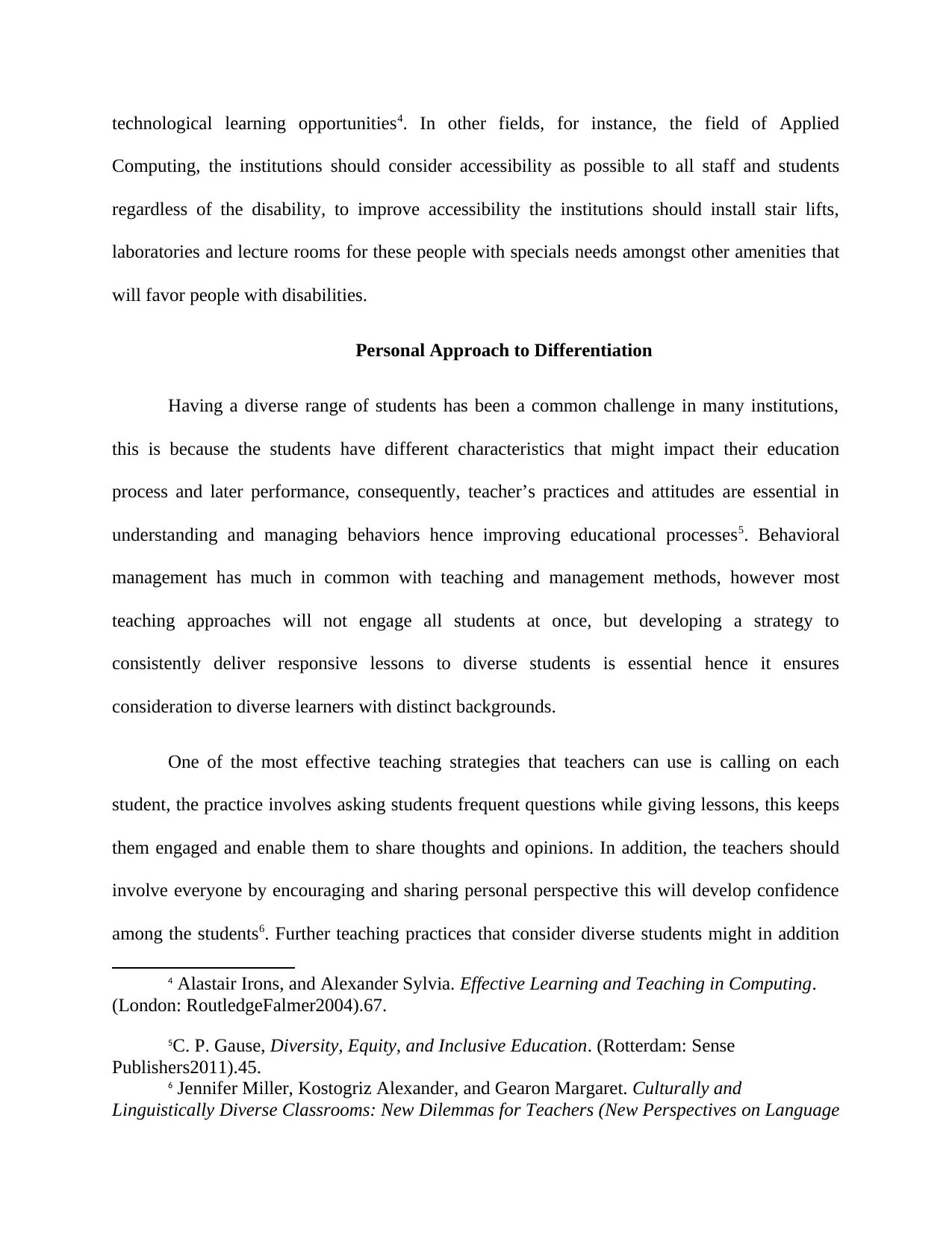
technological learning opportunities4. In other fields, for instance, the field of Applied
Computing, the institutions should consider accessibility as possible to all staff and students
regardless of the disability, to improve accessibility the institutions should install stair lifts,
laboratories and lecture rooms for these people with specials needs amongst other amenities that
will favor people with disabilities.
Personal Approach to Differentiation
Having a diverse range of students has been a common challenge in many institutions,
this is because the students have different characteristics that might impact their education
process and later performance, consequently, teacher’s practices and attitudes are essential in
understanding and managing behaviors hence improving educational processes5. Behavioral
management has much in common with teaching and management methods, however most
teaching approaches will not engage all students at once, but developing a strategy to
consistently deliver responsive lessons to diverse students is essential hence it ensures
consideration to diverse learners with distinct backgrounds.
One of the most effective teaching strategies that teachers can use is calling on each
student, the practice involves asking students frequent questions while giving lessons, this keeps
them engaged and enable them to share thoughts and opinions. In addition, the teachers should
involve everyone by encouraging and sharing personal perspective this will develop confidence
among the students6. Further teaching practices that consider diverse students might in addition
4 Alastair Irons, and Alexander Sylvia. Effective Learning and Teaching in Computing.
(London: RoutledgeFalmer2004).67.
5C. P. Gause, Diversity, Equity, and Inclusive Education. (Rotterdam: Sense
Publishers2011).45.
6 Jennifer Miller, Kostogriz Alexander, and Gearon Margaret. Culturally and
Linguistically Diverse Classrooms: New Dilemmas for Teachers (New Perspectives on Language
Computing, the institutions should consider accessibility as possible to all staff and students
regardless of the disability, to improve accessibility the institutions should install stair lifts,
laboratories and lecture rooms for these people with specials needs amongst other amenities that
will favor people with disabilities.
Personal Approach to Differentiation
Having a diverse range of students has been a common challenge in many institutions,
this is because the students have different characteristics that might impact their education
process and later performance, consequently, teacher’s practices and attitudes are essential in
understanding and managing behaviors hence improving educational processes5. Behavioral
management has much in common with teaching and management methods, however most
teaching approaches will not engage all students at once, but developing a strategy to
consistently deliver responsive lessons to diverse students is essential hence it ensures
consideration to diverse learners with distinct backgrounds.
One of the most effective teaching strategies that teachers can use is calling on each
student, the practice involves asking students frequent questions while giving lessons, this keeps
them engaged and enable them to share thoughts and opinions. In addition, the teachers should
involve everyone by encouraging and sharing personal perspective this will develop confidence
among the students6. Further teaching practices that consider diverse students might in addition
4 Alastair Irons, and Alexander Sylvia. Effective Learning and Teaching in Computing.
(London: RoutledgeFalmer2004).67.
5C. P. Gause, Diversity, Equity, and Inclusive Education. (Rotterdam: Sense
Publishers2011).45.
6 Jennifer Miller, Kostogriz Alexander, and Gearon Margaret. Culturally and
Linguistically Diverse Classrooms: New Dilemmas for Teachers (New Perspectives on Language
⊘ This is a preview!⊘
Do you want full access?
Subscribe today to unlock all pages.

Trusted by 1+ million students worldwide
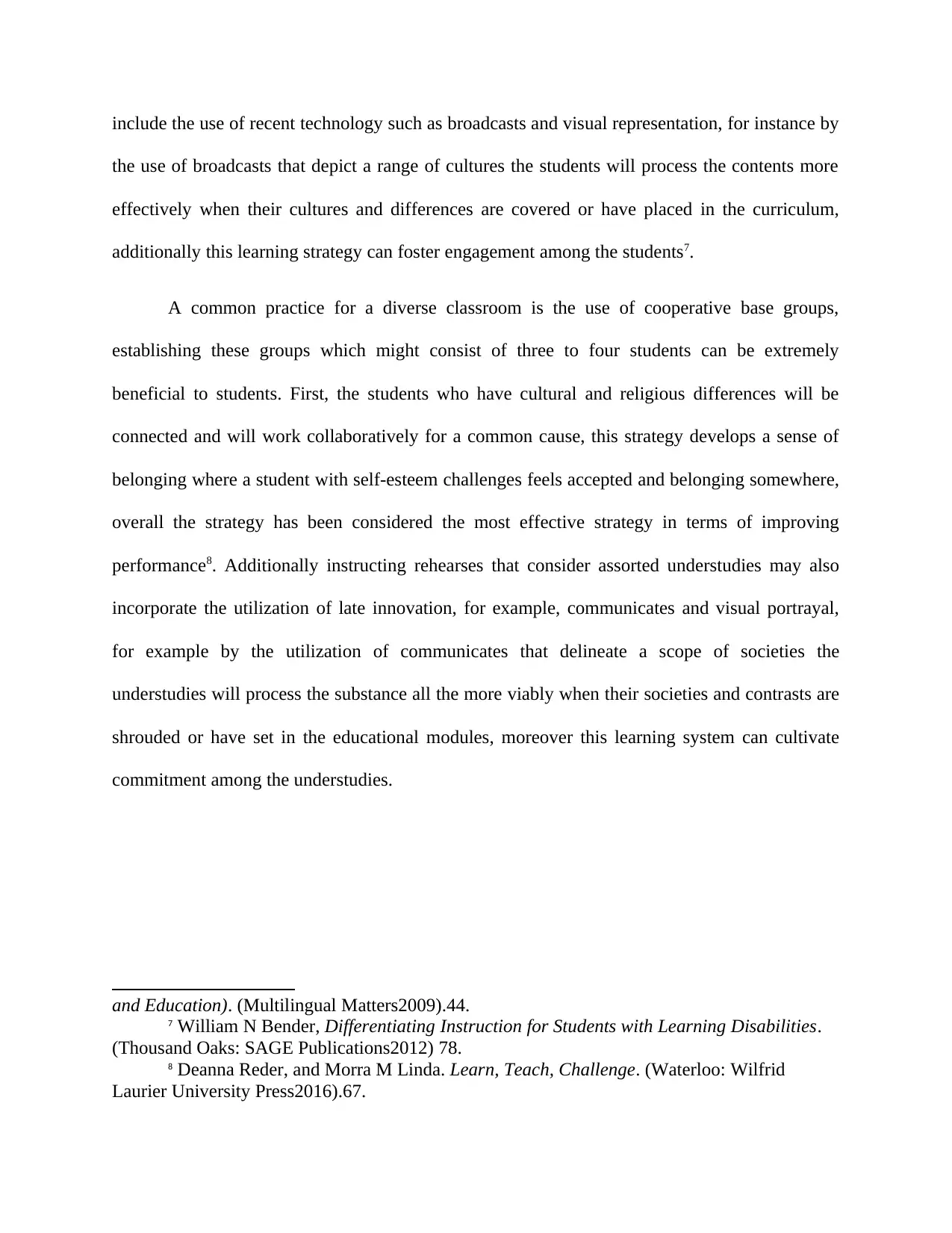
include the use of recent technology such as broadcasts and visual representation, for instance by
the use of broadcasts that depict a range of cultures the students will process the contents more
effectively when their cultures and differences are covered or have placed in the curriculum,
additionally this learning strategy can foster engagement among the students7.
A common practice for a diverse classroom is the use of cooperative base groups,
establishing these groups which might consist of three to four students can be extremely
beneficial to students. First, the students who have cultural and religious differences will be
connected and will work collaboratively for a common cause, this strategy develops a sense of
belonging where a student with self-esteem challenges feels accepted and belonging somewhere,
overall the strategy has been considered the most effective strategy in terms of improving
performance8. Additionally instructing rehearses that consider assorted understudies may also
incorporate the utilization of late innovation, for example, communicates and visual portrayal,
for example by the utilization of communicates that delineate a scope of societies the
understudies will process the substance all the more viably when their societies and contrasts are
shrouded or have set in the educational modules, moreover this learning system can cultivate
commitment among the understudies.
and Education). (Multilingual Matters2009).44.
7 William N Bender, Differentiating Instruction for Students with Learning Disabilities.
(Thousand Oaks: SAGE Publications2012) 78.
8 Deanna Reder, and Morra M Linda. Learn, Teach, Challenge. (Waterloo: Wilfrid
Laurier University Press2016).67.
the use of broadcasts that depict a range of cultures the students will process the contents more
effectively when their cultures and differences are covered or have placed in the curriculum,
additionally this learning strategy can foster engagement among the students7.
A common practice for a diverse classroom is the use of cooperative base groups,
establishing these groups which might consist of three to four students can be extremely
beneficial to students. First, the students who have cultural and religious differences will be
connected and will work collaboratively for a common cause, this strategy develops a sense of
belonging where a student with self-esteem challenges feels accepted and belonging somewhere,
overall the strategy has been considered the most effective strategy in terms of improving
performance8. Additionally instructing rehearses that consider assorted understudies may also
incorporate the utilization of late innovation, for example, communicates and visual portrayal,
for example by the utilization of communicates that delineate a scope of societies the
understudies will process the substance all the more viably when their societies and contrasts are
shrouded or have set in the educational modules, moreover this learning system can cultivate
commitment among the understudies.
and Education). (Multilingual Matters2009).44.
7 William N Bender, Differentiating Instruction for Students with Learning Disabilities.
(Thousand Oaks: SAGE Publications2012) 78.
8 Deanna Reder, and Morra M Linda. Learn, Teach, Challenge. (Waterloo: Wilfrid
Laurier University Press2016).67.
Paraphrase This Document
Need a fresh take? Get an instant paraphrase of this document with our AI Paraphraser
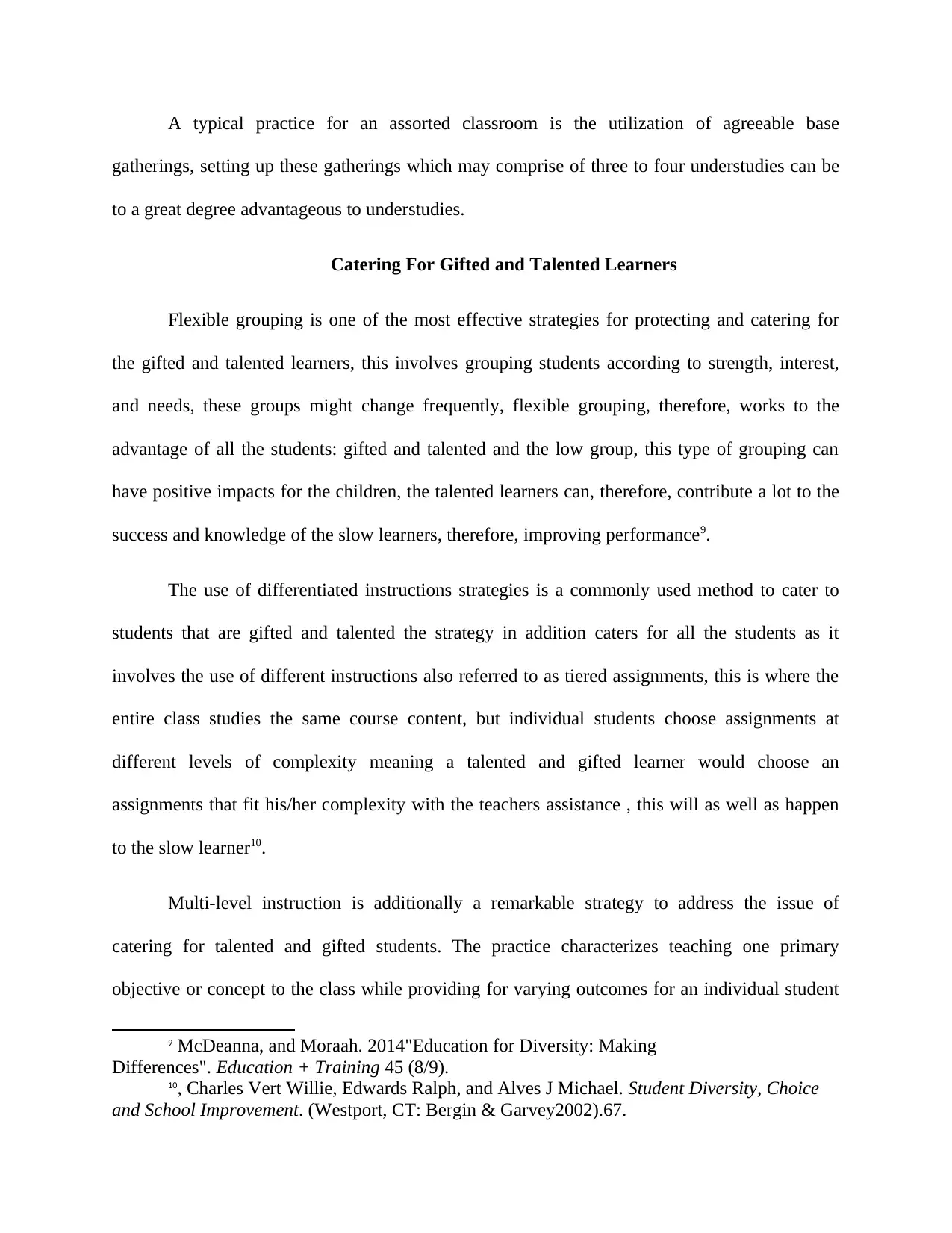
A typical practice for an assorted classroom is the utilization of agreeable base
gatherings, setting up these gatherings which may comprise of three to four understudies can be
to a great degree advantageous to understudies.
Catering For Gifted and Talented Learners
Flexible grouping is one of the most effective strategies for protecting and catering for
the gifted and talented learners, this involves grouping students according to strength, interest,
and needs, these groups might change frequently, flexible grouping, therefore, works to the
advantage of all the students: gifted and talented and the low group, this type of grouping can
have positive impacts for the children, the talented learners can, therefore, contribute a lot to the
success and knowledge of the slow learners, therefore, improving performance9.
The use of differentiated instructions strategies is a commonly used method to cater to
students that are gifted and talented the strategy in addition caters for all the students as it
involves the use of different instructions also referred to as tiered assignments, this is where the
entire class studies the same course content, but individual students choose assignments at
different levels of complexity meaning a talented and gifted learner would choose an
assignments that fit his/her complexity with the teachers assistance , this will as well as happen
to the slow learner10.
Multi-level instruction is additionally a remarkable strategy to address the issue of
catering for talented and gifted students. The practice characterizes teaching one primary
objective or concept to the class while providing for varying outcomes for an individual student
9 McDeanna, and Moraah. 2014"Education for Diversity: Making
Differences". Education + Training 45 (8/9).
10, Charles Vert Willie, Edwards Ralph, and Alves J Michael. Student Diversity, Choice
and School Improvement. (Westport, CT: Bergin & Garvey2002).67.
gatherings, setting up these gatherings which may comprise of three to four understudies can be
to a great degree advantageous to understudies.
Catering For Gifted and Talented Learners
Flexible grouping is one of the most effective strategies for protecting and catering for
the gifted and talented learners, this involves grouping students according to strength, interest,
and needs, these groups might change frequently, flexible grouping, therefore, works to the
advantage of all the students: gifted and talented and the low group, this type of grouping can
have positive impacts for the children, the talented learners can, therefore, contribute a lot to the
success and knowledge of the slow learners, therefore, improving performance9.
The use of differentiated instructions strategies is a commonly used method to cater to
students that are gifted and talented the strategy in addition caters for all the students as it
involves the use of different instructions also referred to as tiered assignments, this is where the
entire class studies the same course content, but individual students choose assignments at
different levels of complexity meaning a talented and gifted learner would choose an
assignments that fit his/her complexity with the teachers assistance , this will as well as happen
to the slow learner10.
Multi-level instruction is additionally a remarkable strategy to address the issue of
catering for talented and gifted students. The practice characterizes teaching one primary
objective or concept to the class while providing for varying outcomes for an individual student
9 McDeanna, and Moraah. 2014"Education for Diversity: Making
Differences". Education + Training 45 (8/9).
10, Charles Vert Willie, Edwards Ralph, and Alves J Michael. Student Diversity, Choice
and School Improvement. (Westport, CT: Bergin & Garvey2002).67.
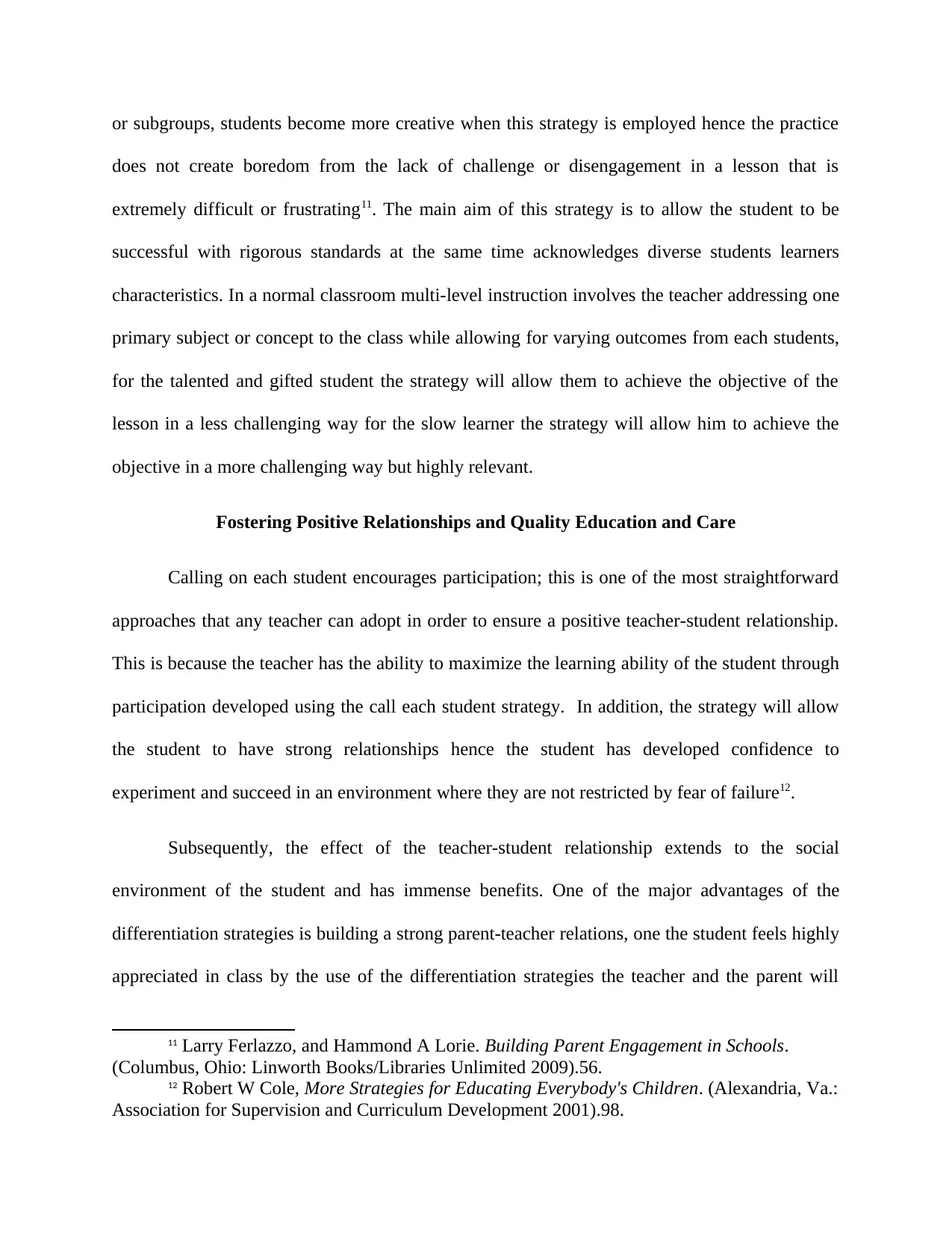
or subgroups, students become more creative when this strategy is employed hence the practice
does not create boredom from the lack of challenge or disengagement in a lesson that is
extremely difficult or frustrating11. The main aim of this strategy is to allow the student to be
successful with rigorous standards at the same time acknowledges diverse students learners
characteristics. In a normal classroom multi-level instruction involves the teacher addressing one
primary subject or concept to the class while allowing for varying outcomes from each students,
for the talented and gifted student the strategy will allow them to achieve the objective of the
lesson in a less challenging way for the slow learner the strategy will allow him to achieve the
objective in a more challenging way but highly relevant.
Fostering Positive Relationships and Quality Education and Care
Calling on each student encourages participation; this is one of the most straightforward
approaches that any teacher can adopt in order to ensure a positive teacher-student relationship.
This is because the teacher has the ability to maximize the learning ability of the student through
participation developed using the call each student strategy. In addition, the strategy will allow
the student to have strong relationships hence the student has developed confidence to
experiment and succeed in an environment where they are not restricted by fear of failure12.
Subsequently, the effect of the teacher-student relationship extends to the social
environment of the student and has immense benefits. One of the major advantages of the
differentiation strategies is building a strong parent-teacher relations, one the student feels highly
appreciated in class by the use of the differentiation strategies the teacher and the parent will
11 Larry Ferlazzo, and Hammond A Lorie. Building Parent Engagement in Schools.
(Columbus, Ohio: Linworth Books/Libraries Unlimited 2009).56.
12 Robert W Cole, More Strategies for Educating Everybody's Children. (Alexandria, Va.:
Association for Supervision and Curriculum Development 2001).98.
does not create boredom from the lack of challenge or disengagement in a lesson that is
extremely difficult or frustrating11. The main aim of this strategy is to allow the student to be
successful with rigorous standards at the same time acknowledges diverse students learners
characteristics. In a normal classroom multi-level instruction involves the teacher addressing one
primary subject or concept to the class while allowing for varying outcomes from each students,
for the talented and gifted student the strategy will allow them to achieve the objective of the
lesson in a less challenging way for the slow learner the strategy will allow him to achieve the
objective in a more challenging way but highly relevant.
Fostering Positive Relationships and Quality Education and Care
Calling on each student encourages participation; this is one of the most straightforward
approaches that any teacher can adopt in order to ensure a positive teacher-student relationship.
This is because the teacher has the ability to maximize the learning ability of the student through
participation developed using the call each student strategy. In addition, the strategy will allow
the student to have strong relationships hence the student has developed confidence to
experiment and succeed in an environment where they are not restricted by fear of failure12.
Subsequently, the effect of the teacher-student relationship extends to the social
environment of the student and has immense benefits. One of the major advantages of the
differentiation strategies is building a strong parent-teacher relations, one the student feels highly
appreciated in class by the use of the differentiation strategies the teacher and the parent will
11 Larry Ferlazzo, and Hammond A Lorie. Building Parent Engagement in Schools.
(Columbus, Ohio: Linworth Books/Libraries Unlimited 2009).56.
12 Robert W Cole, More Strategies for Educating Everybody's Children. (Alexandria, Va.:
Association for Supervision and Curriculum Development 2001).98.
⊘ This is a preview!⊘
Do you want full access?
Subscribe today to unlock all pages.

Trusted by 1+ million students worldwide
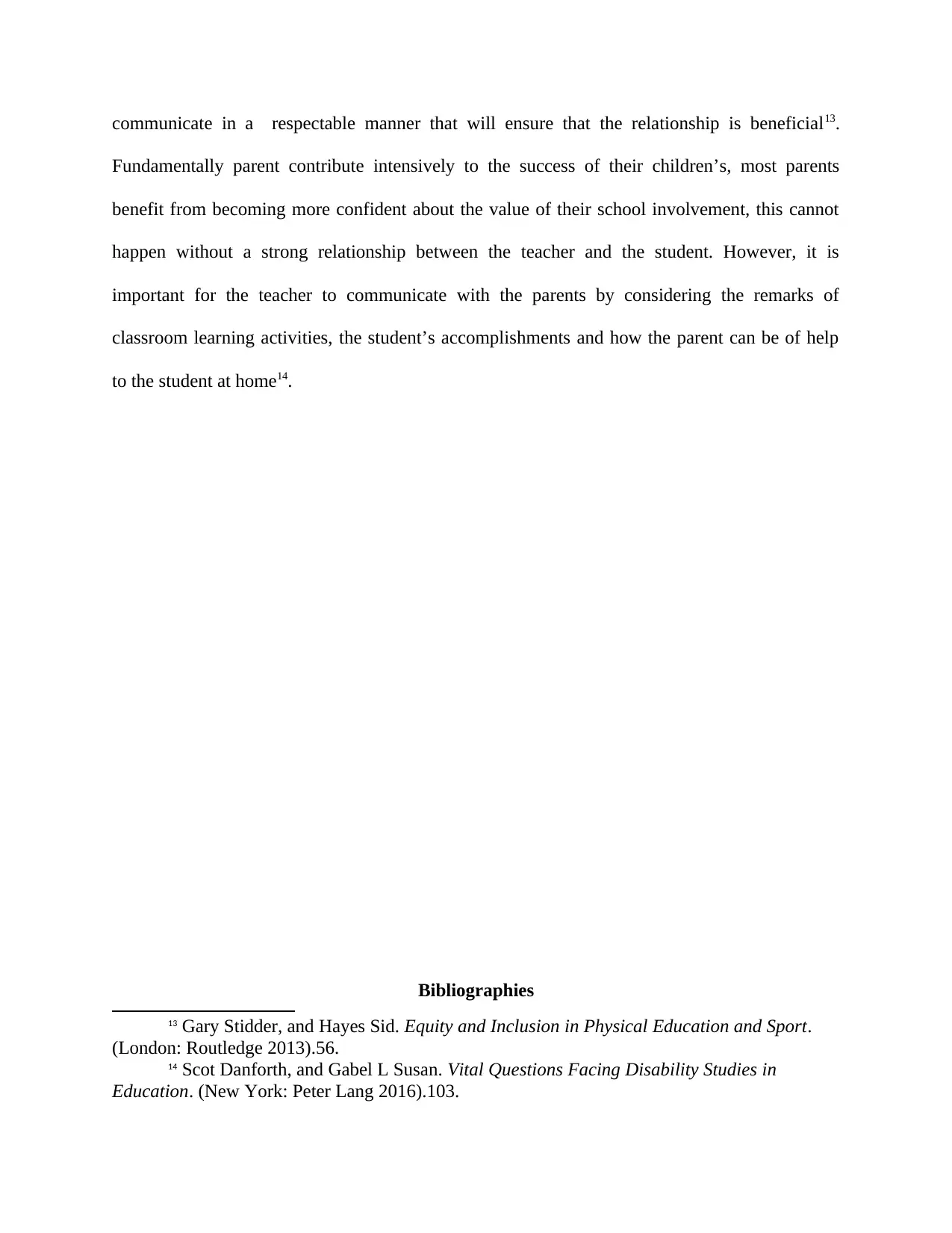
communicate in a respectable manner that will ensure that the relationship is beneficial13.
Fundamentally parent contribute intensively to the success of their children’s, most parents
benefit from becoming more confident about the value of their school involvement, this cannot
happen without a strong relationship between the teacher and the student. However, it is
important for the teacher to communicate with the parents by considering the remarks of
classroom learning activities, the student’s accomplishments and how the parent can be of help
to the student at home14.
Bibliographies
13 Gary Stidder, and Hayes Sid. Equity and Inclusion in Physical Education and Sport.
(London: Routledge 2013).56.
14 Scot Danforth, and Gabel L Susan. Vital Questions Facing Disability Studies in
Education. (New York: Peter Lang 2016).103.
Fundamentally parent contribute intensively to the success of their children’s, most parents
benefit from becoming more confident about the value of their school involvement, this cannot
happen without a strong relationship between the teacher and the student. However, it is
important for the teacher to communicate with the parents by considering the remarks of
classroom learning activities, the student’s accomplishments and how the parent can be of help
to the student at home14.
Bibliographies
13 Gary Stidder, and Hayes Sid. Equity and Inclusion in Physical Education and Sport.
(London: Routledge 2013).56.
14 Scot Danforth, and Gabel L Susan. Vital Questions Facing Disability Studies in
Education. (New York: Peter Lang 2016).103.
Paraphrase This Document
Need a fresh take? Get an instant paraphrase of this document with our AI Paraphraser
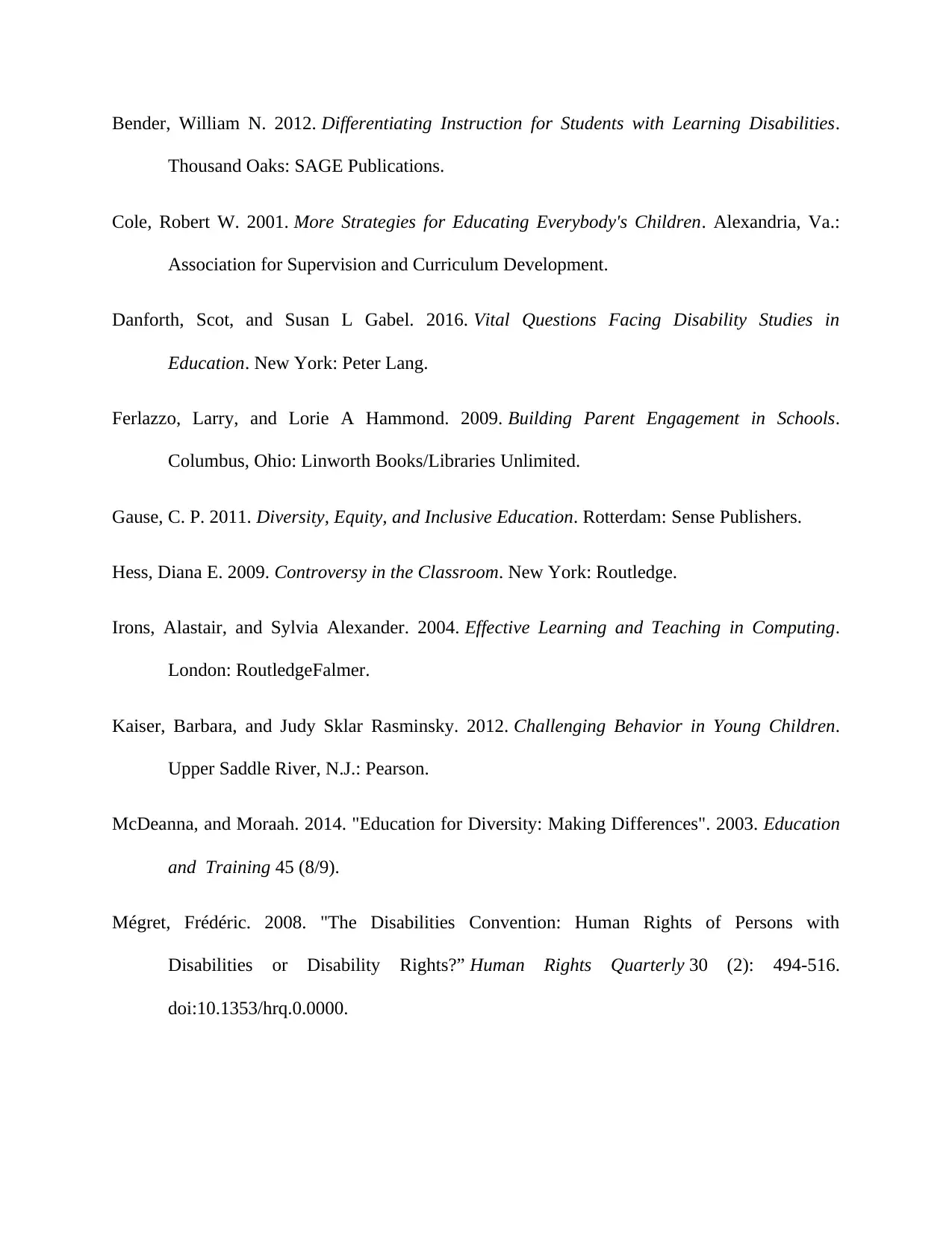
Bender, William N. 2012. Differentiating Instruction for Students with Learning Disabilities.
Thousand Oaks: SAGE Publications.
Cole, Robert W. 2001. More Strategies for Educating Everybody's Children. Alexandria, Va.:
Association for Supervision and Curriculum Development.
Danforth, Scot, and Susan L Gabel. 2016. Vital Questions Facing Disability Studies in
Education. New York: Peter Lang.
Ferlazzo, Larry, and Lorie A Hammond. 2009. Building Parent Engagement in Schools.
Columbus, Ohio: Linworth Books/Libraries Unlimited.
Gause, C. P. 2011. Diversity, Equity, and Inclusive Education. Rotterdam: Sense Publishers.
Hess, Diana E. 2009. Controversy in the Classroom. New York: Routledge.
Irons, Alastair, and Sylvia Alexander. 2004. Effective Learning and Teaching in Computing.
London: RoutledgeFalmer.
Kaiser, Barbara, and Judy Sklar Rasminsky. 2012. Challenging Behavior in Young Children.
Upper Saddle River, N.J.: Pearson.
McDeanna, and Moraah. 2014. "Education for Diversity: Making Differences". 2003. Education
and Training 45 (8/9).
Mégret, Frédéric. 2008. "The Disabilities Convention: Human Rights of Persons with
Disabilities or Disability Rights?” Human Rights Quarterly 30 (2): 494-516.
doi:10.1353/hrq.0.0000.
Thousand Oaks: SAGE Publications.
Cole, Robert W. 2001. More Strategies for Educating Everybody's Children. Alexandria, Va.:
Association for Supervision and Curriculum Development.
Danforth, Scot, and Susan L Gabel. 2016. Vital Questions Facing Disability Studies in
Education. New York: Peter Lang.
Ferlazzo, Larry, and Lorie A Hammond. 2009. Building Parent Engagement in Schools.
Columbus, Ohio: Linworth Books/Libraries Unlimited.
Gause, C. P. 2011. Diversity, Equity, and Inclusive Education. Rotterdam: Sense Publishers.
Hess, Diana E. 2009. Controversy in the Classroom. New York: Routledge.
Irons, Alastair, and Sylvia Alexander. 2004. Effective Learning and Teaching in Computing.
London: RoutledgeFalmer.
Kaiser, Barbara, and Judy Sklar Rasminsky. 2012. Challenging Behavior in Young Children.
Upper Saddle River, N.J.: Pearson.
McDeanna, and Moraah. 2014. "Education for Diversity: Making Differences". 2003. Education
and Training 45 (8/9).
Mégret, Frédéric. 2008. "The Disabilities Convention: Human Rights of Persons with
Disabilities or Disability Rights?” Human Rights Quarterly 30 (2): 494-516.
doi:10.1353/hrq.0.0000.
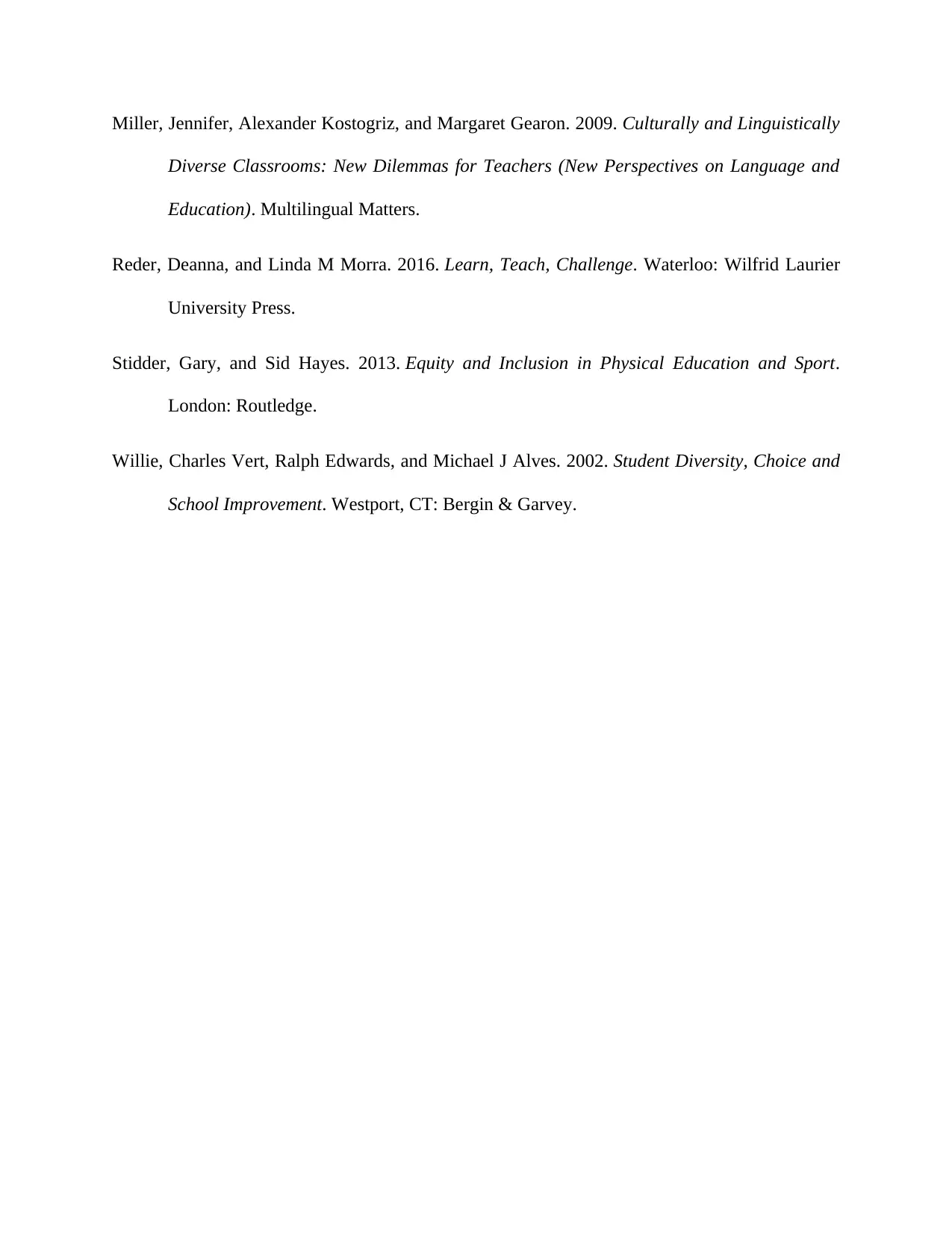
Miller, Jennifer, Alexander Kostogriz, and Margaret Gearon. 2009. Culturally and Linguistically
Diverse Classrooms: New Dilemmas for Teachers (New Perspectives on Language and
Education). Multilingual Matters.
Reder, Deanna, and Linda M Morra. 2016. Learn, Teach, Challenge. Waterloo: Wilfrid Laurier
University Press.
Stidder, Gary, and Sid Hayes. 2013. Equity and Inclusion in Physical Education and Sport.
London: Routledge.
Willie, Charles Vert, Ralph Edwards, and Michael J Alves. 2002. Student Diversity, Choice and
School Improvement. Westport, CT: Bergin & Garvey.
Diverse Classrooms: New Dilemmas for Teachers (New Perspectives on Language and
Education). Multilingual Matters.
Reder, Deanna, and Linda M Morra. 2016. Learn, Teach, Challenge. Waterloo: Wilfrid Laurier
University Press.
Stidder, Gary, and Sid Hayes. 2013. Equity and Inclusion in Physical Education and Sport.
London: Routledge.
Willie, Charles Vert, Ralph Edwards, and Michael J Alves. 2002. Student Diversity, Choice and
School Improvement. Westport, CT: Bergin & Garvey.
⊘ This is a preview!⊘
Do you want full access?
Subscribe today to unlock all pages.

Trusted by 1+ million students worldwide
1 out of 9
Related Documents
Your All-in-One AI-Powered Toolkit for Academic Success.
+13062052269
info@desklib.com
Available 24*7 on WhatsApp / Email
![[object Object]](/_next/static/media/star-bottom.7253800d.svg)
Unlock your academic potential
Copyright © 2020–2025 A2Z Services. All Rights Reserved. Developed and managed by ZUCOL.




